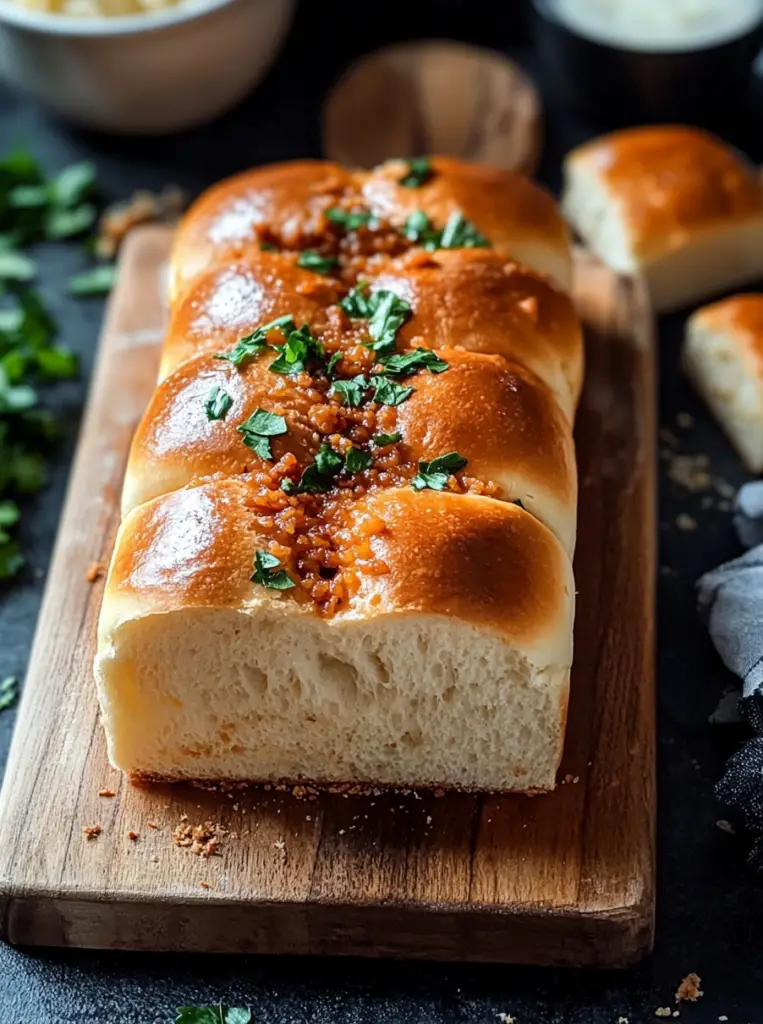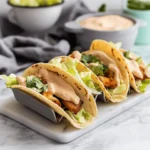This Vegan Pav Bread recipe celebrates the art of plant-based baking with simple ingredients and an elegant method. Perfectly soft and fluffy, its golden crust makes it an ideal pairing for curries, jams, or a variety of dishes. This versatile bread is a must-try for any culinary enthusiast.
Ingredients
- 2 cups all-purpose flour
- 1 tsp salt
- 2 tbsp sugar
- 2 1/4 tsp active dry yeast (1 packet)
- 1/2 cup warm water (110°F to 115°F)
- 1/4 cup unsweetened almond milk or soy milk, lukewarm
- 2 tbsp olive oil or melted coconut oil
- Additional oil for greasing
Directions
- Activate the Yeast:
Dissolve sugar in warm water, add yeast, and let sit until frothy (about 5 minutes). - Mix the Dough:
Combine flour and salt in a large bowl. Add the yeast mixture, lukewarm milk, and oil. Mix until a dough forms. - Knead the Dough:
On a floured surface, knead the dough for 8-10 minutes until smooth and elastic. Place in a greased bowl, cover, and let rise in a warm place until doubled in size (about 1 hour). - Shape and Proof:
Divide the dough into 8 equal pieces and shape into balls. Arrange on a greased baking tray, spaced slightly apart. Cover and let rise again for 30-40 minutes. - Bake:
Preheat oven to 375°F (190°C). Bake for 15-20 minutes, or until golden brown. - Finish:
Brush the baked bread with a small amount of oil for a glossy finish. Allow to cool slightly before serving.
Nutritional Information
- Calories: 180 kcal per serving
- Serving Size: 1 piece
- Servings: 8
Enjoy crafting this fluffy vegan pav bread, a delightful addition to your plant-based recipe collection!
Vegan Pav Bread: A Culinary Marvel in Plant-Based Baking
Bread has been a staple in countless cuisines worldwide, serving as a comforting companion to diverse dishes. Among the myriad bread varieties, pav bread holds a special place, particularly in Indian and global street food culture. This Vegan Pav Bread recipe stands out as a celebration of plant-based baking, delivering the same fluffy, golden goodness of traditional pav, but with a wholesome, vegan twist. Whether you are a seasoned baker or a beginner exploring the joys of bread making, this recipe promises a delightful experience.
The Allure of Pav Bread
Pav, derived from the Portuguese word pão, meaning bread, made its way to India during the colonial era. Over time, it became a beloved addition to Indian cuisine, often paired with dishes like pav bhaji, vada pav, or misal pav. The soft, pillowy texture and slightly sweet undertones make pav bread versatile enough to complement both savory and sweet accompaniments.
This vegan version retains all the characteristics that make pav bread so cherished while catering to those following a plant-based lifestyle. By using simple, accessible ingredients like almond milk and olive oil, this recipe ensures that no flavor or texture is compromised.
The Art of Baking Vegan Pav Bread
Baking bread is as much about the process as it is about the result. The transformative magic of yeast, the tactile satisfaction of kneading dough, and the anticipation as it bakes are experiences that connect you with the age-old art of bread making.
- Yeast Activation: The process begins with activating the yeast, a critical step that ensures the bread rises beautifully. The frothy mixture signifies that the yeast is alive and ready to work its magic on the dough.
- Kneading: Kneading is where the transformation truly begins. As you work the dough, gluten strands form, giving the bread its characteristic elasticity and structure. The 8-10 minutes spent kneading are an investment in the bread’s final texture.
- Proofing: Proofing allows the dough to rest and rise. This step is essential for developing the bread’s light and airy texture. Vegan pav bread benefits from a warm, slightly humid environment during proofing to ensure optimal rise.
- Baking: The oven’s heat is where science meets art. The dough rises further, the crust develops its golden hue, and the aromas of freshly baked bread fill your kitchen.
- Finishing Touch: A light brush of oil post-baking not only enhances the visual appeal but also keeps the crust soft and inviting.
Why Choose Vegan Pav Bread?
- Health Benefits: By using plant-based ingredients, this recipe avoids cholesterol and saturated fats commonly found in dairy or butter-based recipes. Olive oil or coconut oil provides a healthier fat source.
- Dietary Inclusivity: Perfect for vegans and those with dairy allergies, this pav bread is also easily adaptable for gluten-free diets with alternative flours.
- Sustainability: Choosing plant-based recipes contributes to environmental sustainability by reducing reliance on animal products.
- Versatility: This bread’s soft, neutral flavor makes it an excellent canvas for various pairings. Use it to scoop up spicy curries, layer it with vegan butter and jam for breakfast, or serve it as a base for sliders or sandwiches.
Tips for Perfect Vegan Pav Bread
- Measure Accurately: Bread baking is as much science as it is art. Ensure you measure ingredients accurately to achieve the right dough consistency.
- Temperature Control: The water for yeast activation should be warm but not hot (110°F to 115°F). Lukewarm liquid ensures yeast activation without killing the microorganisms.
- Patience: Give the dough ample time to rise. Rushed proofing can result in dense bread.
- Experiment with Flavors: Add herbs, garlic, or seeds to the dough for a twist on the traditional recipe.
- Storage: Store leftover pav bread in an airtight container at room temperature for up to two days or freeze for longer storage.
Serving Ideas for Vegan Pav Bread
Vegan pav bread is as versatile as it is delicious. Here are some ideas to elevate your meal:
- Savory Pairings: Serve with spicy pav bhaji, lentil soups, or roasted vegetables for a satisfying meal.
- Sweet Pairings: Spread vegan Nutella, fruit preserves, or coconut jam for a delightful breakfast or snack.
- Fusion Dishes: Use pav bread as a bun for vegan burgers, sliders, or even mini pizzas.
- Appetizers: Toast slices of pav bread and serve with hummus, guacamole, or vegan cheese spreads.
The Joy of Vegan Baking
Baking bread, particularly a vegan variant, is more than just preparing food—it’s an act of creativity, patience, and love. It connects you to the essence of slow, mindful cooking. Each step, from mixing to proofing and baking, is a tactile and sensory experience that rewards you with the ultimate comfort food.
This Vegan Pav Bread recipe encapsulates the best of plant-based baking, offering a delightful treat that aligns with health and sustainability goals. Whether you’re sharing it with family, serving it at a dinner party, or simply indulging yourself, this pav bread is bound to win hearts.
Conclusion
The journey of crafting Vegan Pav Bread is as rewarding as the final product itself. This simple yet elegant recipe not only satisfies your taste buds but also resonates with the principles of health, sustainability, and inclusivity. Its soft, fluffy texture and golden crust make it a perfect accompaniment to a variety of dishes, ensuring its place as a culinary staple in any kitchen.
By embracing this vegan version of a classic favorite, you’re not just baking bread—you’re making a statement about the possibilities of plant-based cuisine. So, gather your ingredients, knead with love, and relish the joy of creating something truly special. Whether you’re vegan or not, this pav bread is a testament to how delicious and fulfilling plant-based baking can be.







